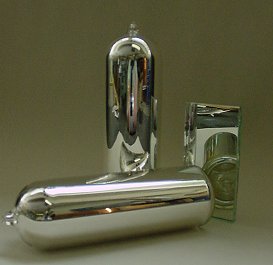 |
 Safety Emporium is a proud sponsor of this site. |
 |
Home Page --> Tutorial Lesson 17, Silvering Glass (Advanced Topic)
|
| Tutorial Lesson 17, Silvering Glass (Advanced Topic) | |
|---|---|
| Lesson 16 (Ring Seals; Advanced) |
Home (No more lessons!) |
Silver Plating - The Brashear Process
The chemistry of this process is described in the Tollen's test which is a physical method that tests for the presence of aldehydes in an organic chemistry laboratory. A video of this process is available through the Royal Society of Chemistry.

|
| ||||||||
Solutions are used at the following ratio: 1 : 2 : 3 = 64% : 32% : 4% by volume. Cut out this handy table and stick it on your shop wall as a quick reference so you don't need to calculate volumes:
| Solution Required | Solution 1 | Solution 2 | Solution 3 |
|---|---|---|---|
| 50 | 32 | 16 | 2 |
| 100 | 64 | 32 | 4 |
| 150 | 96 | 48 | 6 |
| 200 | 128 | 64 | 8 |
| 250 | 160 | 80 | 10 |
| 300 | 192 | 96 | 12 |
| 400 | 256 | 128 | 16 |
| 500 | 320 | 160 | 20 |
| 600 | 384 | 192 | 24 |
| 700 | 448 | 224 | 28 |
| 800 | 512 | 256 | 32 |
| 900 | 576 | 288 | 36 |
| 1000 | 640 | 320 | 40 |
| 1500 | 960 | 480 | 60 |
| 2000 | 1280 | 640 | 80 |
To use: First ensure that your glassware to be silvered is scrupulously clean. Then, add concentrated ammonium hydroxide dropwise to Solution 1 with stirring. It will form a precipitate with the first drop; continue adding until the precipitate clears. This should require no more than an eye dropper's worth of ammonium hydroxide for volumes up to ~500 mL. Add Solution 2 to Solution 1. The combined solutions will have a creamy white precipitate. Stir the solution and again add concentrated ammonium hydroxide dropwise until the solution is slightly cloudy. Pour the solution into the glass vessel to be silvered. Add solution 3 and stir/shake while the mirror develops.
Warning: Wear protective clothing and read the MSDS for all materials that you use. Promptly and safely discard unused mixed solutions.
We hope to post some pictures here that demonstrate a Dewar flask being made. Stay tuned!
| Tutorial Lesson 17, Silvering Glass (Advanced Topic) | |
|---|---|
| Lesson 16 (Ring Seals; Advanced) |
Home (No more lessons!) |